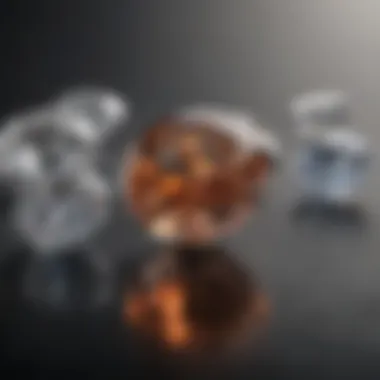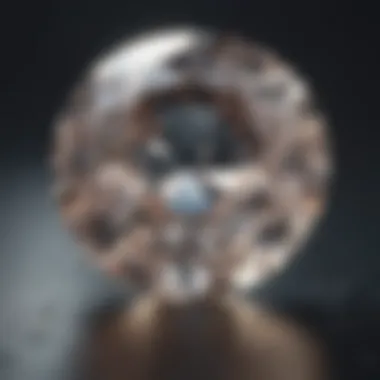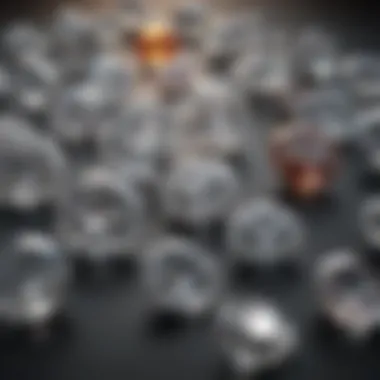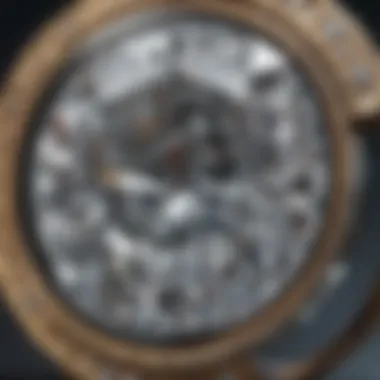Understanding Diamond Carat Sizes with Visual Aids


Intro
Diamonds have that special shimmer that draws people in, but when it comes down to choosing the right one, many get tangled in the technicalities. The size of a diamond isn't just about its weight in carats; it's about how that weight translates into visual impact. This guide aims to unravel the mysteries surrounding diamond carat sizes through clear visuals and accessible descriptions, so you don’t end up feeling like a deer in headlights at the jeweler's.
Understanding diamond carat sizes means understanding how weight correlates with size, but it’s more nuanced than it seems. Not every carat is equal; the cut, shape, and overall brilliance can make a world of difference in how a diamond appears. The goal here is to turn you into a well-informed buyer, ready to choose not only wisely but beautifully.
Overview of Gemstones and Minerals
Diamonds, along with a variety of gemstones, have captivated human civilization for centuries. Understanding the broader context of gemstones and minerals helps appreciate where diamonds fit in the grand scheme.
History of Gemstone and Mineral Use
From the ancient Egyptians adorning themselves with garnets and emeralds to modern jewelers crafting exquisite engagement rings, gemstones have always played a crucial role in different cultures. Diamonds, while only discovered for their true value relatively recently, have become symbols of love and commitment.
Significance in Culture and Society
Gemstones often carry significant weight in cultural symbolism. In many societies, certain stones are believed to bring luck, protection, or even healing. Diamonds, particularly, have come to signify enduring love and high status, merging personal sentiment and social implications in their allure.
"In a world full of trends, a diamond remains a classic."
Gemstone Formation and Properties
Understanding how diamonds and other gemstones are formed can shed some light on their mystical appeal. Each gemstone has a unique story that contributes to its value.
Formation Process of Gemstones
Diamonds are born deep within the Earth, nearly 100 miles down, under conditions of immense pressure and temperature. Over time, volcanic activity brings them closer to the surface, where human hands can eventually discover them. Other gemstones, like sapphires and rubies, often form through different geological processes, showcasing nature's artistry.
Properties that Define Gemstones
Each gemstone has distinctive properties that affect its appearance and appeal. For diamonds, these include hardness, refractive index, and clarity. The ‘Four Cs’—carat, cut, color, and clarity—determine a diamond’s quality and price, turning each gemstone into a unique work of art borne from the Earth.
Classification based on Color, Hardness, and Luster
Diamonds are not just one flavor; they exhibit a myriad of colors—from the classic clear to stunning yellows and blues. Alongside color, hardness varies greatly across the spectrum of gemstones, with diamonds being at the top of the Mohs scale. Luster plays a vital role too; a diamond’s ability to reflect light contributes significantly to its perceived size and beauty.
Types of Gemstones
When navigating the world of gemstones, being aware of the different types can be quite enlightening.
Precious vs. Semi-Precious Gemstones
Traditionally, gemstones are categorized into precious and semi-precious. Precious gemstones like diamonds, emeralds, rubies, and sapphires are valued for their rarity and aesthetic appeal, whereas semi-precious stones are often more abundant but still possess unique beauty.
Common Gemstone Varieties
Some of the more popular gemstones you might encounter include:
- Amethyst
- Aquamarine
- Peridot
- Tourmaline Each of these stones has its own slice of popularity for various reasons, whether it’s color, lore, or simply demand.
Exotic and Rare Gemstones
In the hidden corners of the Earth, you can find exotic gemstones like Tanzanite or Alexandrite, often commanding a high price due to their rarity. Collectors often seek these stones, adding unique flair to their collection.
Identifying and Evaluating Gemstones
Identifying and appraising gemstones can be quite the undertaking when it comes to buying a diamond.


Factors Affecting Gemstone Value
Factors such as origin, color intensity, clarity, and even market demand contribute to a stone's value. A diamond's clarity can greatly impact how size is perceived, with a high clarity rating often allowing more light to pass through, enhancing its sparkle.
Techniques for Gemstone Identification
Practices such as using a jeweler's loupe, assessing clarity and cut, and employing even advanced lab techniques, help identify genuine stones from imitations.
Assessing Gemstone Quality
When purchasing a diamond, it's essential to not only consider carat size but also cut quality. A well-cut diamond can appear larger and more brilliant compared to one of the same carat weight that is poorly cut.
Caring for Gemstones
Just as buying gemstones requires knowledge, so does maintaining them.
Cleaning and Storing Gemstones Properly
Regular cleaning using gentle soap and lukewarm water can keep diamonds sparkling. Storing each piece separately can help prevent scratches and damage.
Avoiding Common Mistakes in Gemstone Care
One common pitfall is exposing gemstones to harsh chemicals, which can dull their shine. Regular inspections help catch any wear and tear early on, prolonging the life of your collection.
Preservation Tips for Specific Gem Types
Different gemstones have specific needs. For instance, opals require humid environments while diamonds, being the toughest, can withstand more but still need care in how they are handled.
By understanding these foundational aspects of gemstones, particularly diamond carat sizes, one is better prepared to navigate the often overwhelming market of fine jewels. Armed with knowledge, a gem enthusiast can make decisions that resonate with both their style and practical needs.
Preamble to Diamond Carat Sizes
Understanding diamond carat sizes is fundamental for anyone engaged in the world of gemstones, whether you are a collector, a jewelry designer, or a simple enthusiast. This section sets the groundwork to navigate the complexities of carat weight and how this measurement plays a pivotal role in the diamond's pricing and perceived value.
Carat weight, although frequently associated with how large a diamond looks, can be a bit deceiving. It’s not just about the number on a scale but how that number translates into a diamond's appearance, influenced by various factors like cut, shape, and setting. This is where the nuances come into play.
Defining Carat Weight
Carat weight refers to the weight of the diamond, with one carat being equal to 200 milligrams. The term 'carat' originally comes from carob seeds, which were historically used as a standard for weighing precious stones. While many may believe that higher carat weight directly equates to a larger diamond, that’s not always the case.
For example, a one-carat diamond does not necessarily look the same across different cuts. A well-cut diamond may appear larger compared to another of the same weight that has been poorly cut. The standard unit allows buyers to compare stones easily, but it shouldn't overshadow other critical details.
"It’s not just about weight, it’s about what that weight delivers visually."
Importance of Carat in Pricing
When it comes to pricing, carat weight plays a significant role. Diamonds are priced per carat, meaning that as weight increases, the price per carat usually jumps. For instance, a two-carat diamond often costs exponentially more than two one-carat diamonds.
However, this is not a straightforward equation. Factors such as market demand, rarity, and the overall quality of the stone tie into this pricing model.
- Market demand: Certain carat weights are more sought after than others.
- Rarity: A perfectly cut three-carat diamond can be pricier than a poorly cut five-carat diamond.
- Jewelry setting: The choice of mounting can affect the perception of size, impacting pricing as well.
To sum it up, while carat weight is a primary indicator of value, it’s crucial to assess diamonds holistically. This consideration becomes especially relevant when working with visual representations of sizes, as they offer clarity on what to expect beyond just the number of carats.
Visual Comparisons of Carat Sizes
One of the primary themes of this article centers around the visual representations of diamond carat sizes. Understanding how different carats appear side by side can be vital for both new buyers and seasoned enthusiasts. If someone is eyeing a one-carat diamond and wonders how it stacks up against its two-carat counterpart, visuals provide a compelling perspective. We often don't grasp sizes fully until we see them compared in real-life scenarios. Visual comparisons strip away the ambiguity that numbers alone present, creating a bridge between conceptual understanding and tangible reality.
Carat Sizes from Less Than One to Five Carats


Comparing Half-Carat Diamonds
Half-carat diamonds are quite popular, especially for those looking to make a statement without breaking the bank. In terms of appearance, a half-carat diamond might initially seem small, but its precise brilliance and carefully executed cut can create a perception of more size than the number suggests. Many people appreciate half-carat diamonds as perfect choices for earrings or delicate pendants. They’re subtle yet beautiful choices that serve as a great entry point into the world of diamonds, without overwhelming the wearer.
However, the downside to half-carat stones lies in their vulnerability to getting overshadowed. In larger settings, for instance, a half-carat diamond could appear lost, especially when surrounded by several smaller stones or larger metals. Still, the unique features of half-carat diamonds include their affordability and appeal to minimalist aesthetics. This allows wearers to enjoy sparkle without the hefty price tag.
Three-Carat Dimension Visuals
Visualizing a three-carat diamond opens another door entirely. At three carats, the diamond makes a noticeable presence. The weight gives it a certain gravitas that often leads to a more dramatic sparkle, especially when cut well. Moreover, in settings that emphasize the stone, such as in a solitaire ring, it can become the focal point. Three-carat diamonds tend to be versatile, ranging from engagement rings to statement pieces.
Yet, bigger isn't always better, as it can sometimes create discomfort while wearing. It's crucial to visualize how it feels on the hand or ear; weight can be less comfortable than a smaller size. Further, the unique aspect of a three-carat diamond is its ability to shine brightly and attract attention, proving popular for those looking to make their mark. However, one should consider the impact of setting and how it might affect the perceived size.
Notable Size Differences
Carat vs Carat
When exploring the difference between two-carat and three-carat diamonds, one may wonder if the extra carat justifies the gulf in price. The visual implication is significant; at a glance, the differences are more than just numerical. The three-carat diamond often gives off a beam of light that seems more pronounced, enhancing its appeal. This distinction can be alluring, especially if one is considering the purchase for significant occasions.
That said, two-carat diamonds offer an elegance of their own and frequently come with a more manageable price tag. They can fit well in multiple settings without appearing cumbersome. Bigger stones can sometimes dwarf the wearer, especially if they have smaller hands. Hence, choosing between two and three carats boils down to preferences about style and statement.
Carat Variations
Four-carat diamonds occur in a galaxy of styles and cuts. The weight starts becoming more Than just about glimmer; it’s about statement, identity, and personal branding. The luxury of wearing a four-carat diamond is significant. However, the visual challenge is essential to note. This size can often seem overpowering if the person wearing it isn’t accustomed to managing larger pieces.
Those interested in four-carat diamonds should be aware of how the cut can change its apparent size. An ideal cut can amplify light, making it seem even larger. On the flip side, poor cuts can cause a four-carat diamond to appear smaller than a well-cut three-carat stone. Therefore, familiarity with cut characteristics should guide one's choice in sizes, ensuring satisfaction in the long run.
"Visual understanding of diamonds allows buyers to make better decisions while navigating through choices of size, cut, and setting. All these elements weave together the tale of what a diamond truly represents."
In exploring these different diamond sizes and their visual manifestations, we become equipped with insights that make our gemstone journeys clearer and more informed.
Factors Influencing Diamond Size Perception
Understanding how we perceive diamond size is crucial for anyone navigating the intricate world of gemstones. Several integral factors shape this perception, including the diamond cut, its shape, and the setting in which it is displayed. These elements not only influence the physical appearance of a diamond but also its overall appeal and market value. Let's dive deeper into each influencing factor to clarify how they intersect with the overall topic.
Impact of Diamond Cut
Understanding Cut Quality
Cut quality is arguably one of the most significant factors affecting a diamond's size perception. It encompasses how well the diamond's facets reflect light and how effectively it is shaped. A diamond with superior cut quality reflects more light, enhancing its overall brilliance, which can make it appear larger than a poorly cut diamond of the same carat weight. Cut quality is graded on a scale that includes terms like Excellent, Very Good, and so forth, with excellent being the most desirable. The reason this aspect is a popular choice in this discussion is that even a diamond with lower carat weight can dazzle when cut well, sometimes making it appear closer to a heavier stone.
The unique feature of cut quality lies in its direct relationship with light performance, which can either amplify or diminish a diamond's visual size. A disadvantage could be that achieving an ideal cut can sometimes lead to weight loss in stones, as rough material is shaped to enhance its aesthetic.
Brilliance and Sparkle
Brilliance and sparkle are what many people first notice when looking at diamonds, and these qualities are essential in the discussion about size perception. A diamond that sparkles vigorously produces the visual illusion of size, drawing the eye and enticing potential buyers. Essentially, the more light that is reflected, the more the diamond can trick the eye into seeing a larger size than it is.
This sparkling effect is not merely a byproduct of one aspect; several factors including the diamond’s cut, quality, and the arrangement of its facets all contribute to its brilliance. However, achieving this effect can sometimes mean sacrificing other qualities, causing a vibrant appearance at the expense of durability. Hence, while brilliance is an appealing factor, it should be balanced against other considerations in one's selection process.
Shape Variations
Round vs. Fancy Shapes
When we talk about shape variations, the age-old debate between round and fancy shapes emerges. Round diamonds, thanks to their classic cut and historic popularity, tend to dominate the market, and they possess the unique ability to maximize light reflection, making them a widespread favorite. However, fancy-shaped diamonds—like oval or pear—bring personality and unique flair to the table. This variety can strike collectors who prefer something outside of the norm. The distinctiveness of fancy shapes can create an illusion of size, especially if the design elongates the outline without adding too much carat weight.
The real advantage of fancy shapes is their ability to stand out in a crowd of round diamonds. However, because they are less traditional, they might not always receive the premium pricing that rounds do, which can influence buyer perceptions varying from status symbol to personal taste.
Influence of Shape on Size Perception
Shape also plays a pivotal role in influencing how a diamond is perceived by onlookers. For instance, long shapes, like marquise or oval diamonds, appear visually larger because of their elongated proportions. This phenomenon happens as the shape draws the eye and allows the wearer to enjoy a more sizeable visual impact. Conversely, a square or cushion-cut diamond may seem more compact, giving the impression of a smaller stone.


The beauty in understanding this aspect lies in its simplicity; a shift in shape can create a significant difference in visible size. The drawback, however, is that not all shapes are equally appealing to every individual, and personal preferences will always come into play when discussing perceived size.
Setting Choices
Alterations in Visual Size
The way a diamond is set in jewelry often affects its size perception dramatically. The design of the ring or pendant, including the band thickness and the presence of surrounding stones, can enhance or even obscure the diamond itself. Some settings, like halo settings, feature smaller diamonds that flank the center stone. This arrangement can make the main diamond look more significant than it actually is, creating an optical illusion.
This characteristic of visual enhancement through design is vital for buyers who want their diamond to pack a visual punch without necessarily increasing the carat weight. However, prospective wearers must be cautious, as overly elaborate settings might detract from the diamond's unique properties if not chosen wisely.
Metal Types and Their Effects
Lastly, the metal type used in the setting of the diamond contributes to the overall perception of size. For example, white gold or platinum tends to reflect more light compared to yellow gold, which may alter how the diamond is perceived. Additionally, the contrast between the metal and the diamond plays a crucial role; a lighter stone set in a dark metal will appear less vibrant, impacting the overall size impression.
The unique feature of this influence is that it allows for customization in presentation. However, this may lead to confusion for buyers who may not fully understand how the metal can alter their expected visual impact. Being informed about these nuances helps ensure a better decision as one embarks on a diamond purchase.
Common Misconceptions About Carat Sizes
When discussing diamonds, carat size becomes a focal point for many buyers. Yet, there’s more than meets the eye when it comes to understanding what those carats actually represent. Addressing common misconceptions regarding carat sizes is essential for guiding enthusiasts and collectors in their purchases. Misunderstandings in this area can lead to dissatisfaction, misjudgment in value, and ultimately, poor investment decisions.
One prevalent misconception is the assumption that carat weight directly correlates with the physical size of the diamond. While it’s true that higher carat weights generally indicate bigger diamonds, this isn't a straightforward relationship. Other factors, like cut, shape, and even the mounting settings can heavily influence how large a gemstone appears to the naked eye.
Additionally, folks often believe that “more is better” regarding carat weight, neglecting other vital aspects of a diamond’s beauty, such as cut quality and clarity. A wonderful stone with a lower carat weight might outshine a heavier stone if cut and clarity are not prioritized. Recognizing these nuances can dramatically improve one's selection process.
Diamonds aren’t merely a number on a scale; they’re a symphony of artistry, ranging in size and luster, each with its own unique allure.
Let’s break down these misconceptions with clarity.
Weight vs. Size Differences
In the diamond world, a common misjudgment is that a heavier diamond will always appear larger. This notion hinges solely on the carat metric and disregards the different shapes and cuts available. For instance, a two-carat round diamond might look smaller than a two-carat oval diamond due to their differing proportions and surface areas. Round diamonds tend to retain more weight in their depth, which might diminish their apparent size as seen from above.
Moreover, how a diamond is set can also skew size perception. For example, a diamond set in a halo might appear larger than its actual carat weight due to the surrounding smaller stones enhancing its visual impact. Thus, it’s not about the numbers alone; it’s about how those numbers are manifested in the final product.
Quality vs. Quantity
Another common pitfall in understanding diamonds lies in equating carat weight with overall value. While carat is indeed a factor in pricing, it shouldn't overshadow the quality metrics like cut, color, and clarity. Quality matters significantly; a stunning one-carat diamond with excellent cut and clarity can be worth more than a two-carat diamond that is poorly cut or heavily included.
When making a choice, it's also essential to consider personal priorities. Are you seeking something that sparkles or is more about the size? Being intentional with this mindset can lead to more fulfilling decisions. Remember, each diamond is unique and shines in its own right, regardless of its carat weight. Thus, focusing solely on quantity can cloud one's judgment.
In summary, by dismissing these misconceptions about diamond carat sizes, collectors and enthusiasts can equip themselves with better knowledge. Understanding the intricate balance between carat weight, quality, and the overall aesthetic will enable a more informed and rewarding diamond journey.
Finale: Making Informed Choices
In the realm of gemstones, the journey of selecting the right diamond hinges significantly on understanding carat sizes. This conclusion encapsulates the critical insights that have emerged from our discussions about diamond carat weights and their visual representations. By drawing connections between weight, cut, and overall appearance, you can navigate the intricate choices presented in today’s market more effectively. Whether you're a collector or just looking to make a memorable purchase, recognizing these nuances is paramount.
Emphasizing Quality Over Quantity
Delving into the diamond world often leads prospective buyers to a common pitfall: prioritizing carat weight over the stone's overall quality. While a sizable diamond can indeed catch one's eye, it is vitally important to remember that the brilliance and aesthetic of a diamond largely depend on its cut, clarity, and color. A one-carat diamond that is cut for maximum light return can appear more dazzling than a larger stone with a poor cut.
When considering a diamond, think of these factors:
- Cut Quality: This greatly influences how the diamond interacts with light, affecting its sparkle.
- Clarity: A few inclusions or blemishes in a larger stone can detract more from its appearance than a smaller, clearer stone.
- Color: Diamonds with less color generally command higher prices and provide more visual appeal.
Therefore, emphasizing quality over quantity nurtures a more rewarding and satisfying acquisition experience.
Final Thoughts on Carat Size Selection
As you move towards making that final choice in selecting the ideal diamond, reflect deeply on what truly matters to you. The carat size should align with your personal desires and practical considerations. Will the diamond be part of a piece designed to be worn every day, or is it meant for special occasions? The setting style, alongside carat size, influences how a diamond will ultimately be perceived.
Choosing wisely involves a few key strategies:
- Visual Aids: Use visual comparisons and tools available online to understand how different carat weights actually look in real life.
- Try Before You Buy: Whenever possible, visit a reputable jeweler to see diamonds in various settings to appreciate their appearance firsthand.
- Budget Considerations: Keep an eye on your budget; an educated choice can lead to a stunning diamond that meets your standards without breaking the bank.
In summary, understanding diamond carat sizes deeply enhances your purchasing power, guiding you towards making informed, thoughtful choices in your gemstone endeavors. Your satisfaction and joy in your chosen piece hinge on such understanding, ensuring that each diamond shines as brightly as your intentions behind selecting it.







